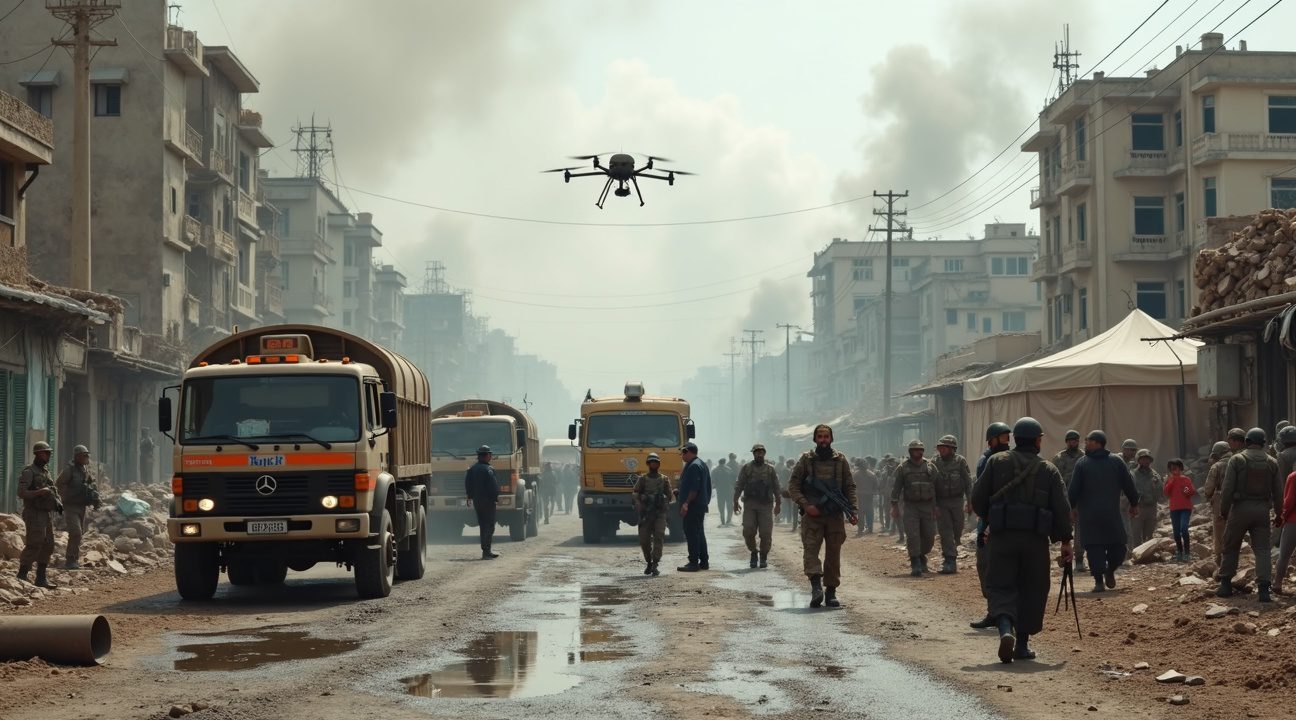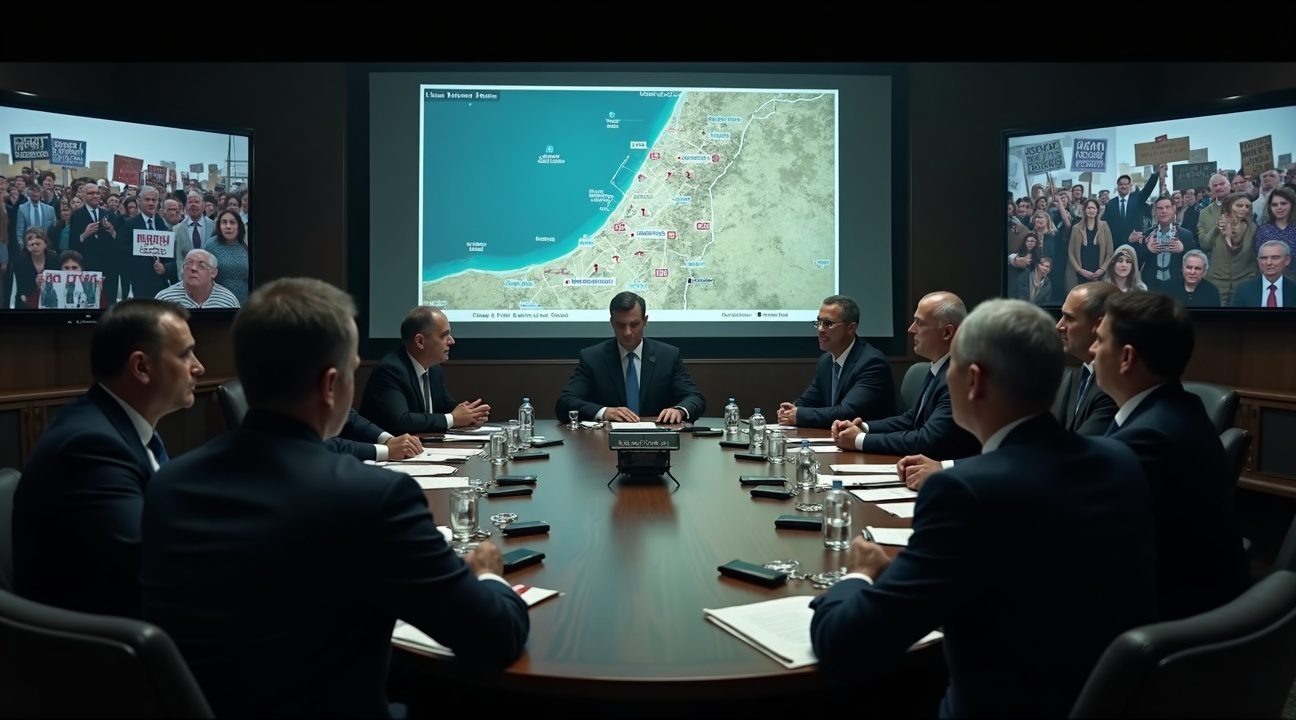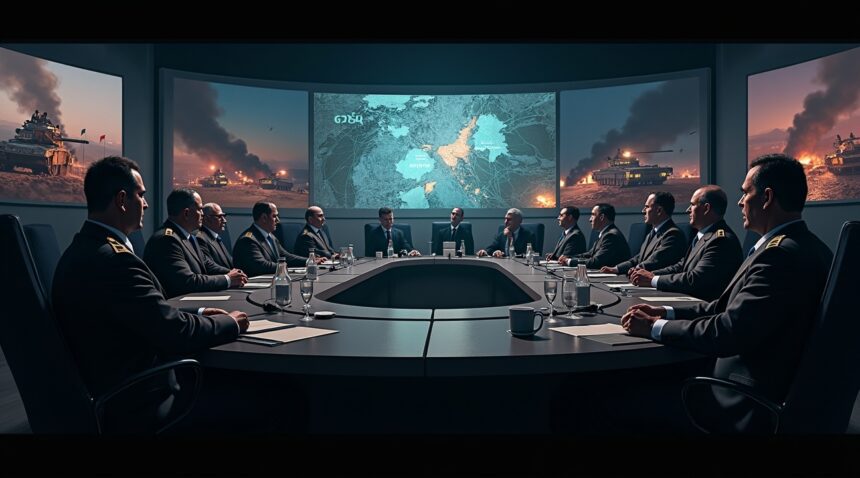On August 8, 2025, Israel’s Security Cabinet approved a plan to seize Gaza City, marking a major shift from defensive measures to active military and territorial control, heightening tensions in an already volatile conflict.
Key Takeaways
- The Israeli Security Cabinet approved a comprehensive plan to seize Gaza City, passing by majority vote. This move marks a deliberate strategic escalation in the ongoing conflict.
- The operation targets five core objectives: disarming Hamas, retrieving hostages, achieving complete demilitarization of Gaza, limiting civilian casualties, and maintaining humanitarian aid in designated non-combat zones.
- International response remains deeply divided, with the United Nations warning of a dangerous escalation, and Hamas denouncing the move as a series of war crimes. Diplomatic reactions vary across regions.
- Humanitarian aid efforts face mounting challenges as urban combat intensifies. Supply route disruptions, risk to aid workers, and displacement of residents compound operational difficulties.
- The decision reflects increasing domestic pressure in Israel for a decisive response, particularly regarding hostage recovery. While some allies defend the necessity of the operation, others urge restraint.
For More Information
For detailed insight into the ongoing developments, you can follow regular updates from the United Nations and regional news sources tracking the situation in Gaza City.
Israeli Security Cabinet Greenlights Gaza City Seizure in Majority Vote
I witnessed a critical turning point in Middle Eastern politics on August 8, 2025, when the Israeli Security Cabinet made a decision that would reshape the regional landscape. The high-level security body approved a comprehensive plan to seize control of Gaza City through a majority vote, marking one of the most significant escalations in the ongoing conflict between Israel and Gaza.
The decision emerged from intensive deliberations among Israel’s top security officials, with directives flowing directly from the Prime Minister’s Office. This wasn’t a rushed judgment but rather a calculated strategic move that had been under consideration by the Israeli military leadership for an extended period. The approval represents a decisive shift in Israel’s approach to Gaza, moving from defensive operations to an active seizure strategy.
Scope and Strategic Focus of the Operation
The approved plan demonstrates a carefully calibrated approach that stops short of full territorial occupation. Rather than attempting to control the entire Gaza Strip, Israeli officials have chosen to concentrate their efforts on Gaza City specifically. This focused strategy suggests that the Israeli Security Cabinet recognizes both the strategic importance of the city and the practical limitations of broader territorial control.
Gaza City serves as the political and economic heart of the territory, making its capture particularly significant from both symbolic and operational perspectives. The decision to limit the scope to the city rather than the entire strip indicates that Israeli planners have considered the logistical challenges and international implications of a more extensive occupation plan.
The timing of this decision coincides with various geopolitical factors that may have influenced the Security Cabinet’s calculus. Entertainment industry developments continue alongside these serious political developments, highlighting how different sectors of society operate simultaneously during times of conflict.
Military and Political Implications
The majority vote within the Security Cabinet signals broad consensus among Israel’s security establishment about the necessity of this escalation. This level of agreement among top officials suggests that the decision wasn’t taken lightly and reflects significant intelligence assessments about the current situation in Gaza. The Israeli military has likely been preparing contingency plans for such an operation well before the formal approval.
The distinction between seizing Gaza City and occupying the entire Gaza Strip carries important implications for international law and diplomatic relations. By limiting the scope to the city, Israeli officials may be attempting to minimize certain legal and political complications while still achieving their strategic objectives.
This development marks a clear escalation from previous Israeli operations in Gaza, which typically focused on targeted strikes or temporary incursions. The plan for sustained control of Gaza City represents a fundamental shift in military strategy and political objectives. The decision reflects the Security Cabinet’s assessment that previous approaches haven’t achieved desired security outcomes.
The approval process itself demonstrates the formal mechanisms through which Israel makes critical security decisions. The majority vote requirement ensures that such significant military actions receive broad support from the country’s security leadership rather than being unilateral decisions.
Regional observers note that this escalation could trigger various responses from neighboring countries and international bodies. The focused nature of the operation on Gaza City specifically may influence how other regional actors respond to this development. Cultural milestones often provide contrast to such serious political developments, reminding us of the diverse aspects of human experience that continue during times of conflict.
The Israeli Security Cabinet’s decision represents a calculated risk that could reshape the dynamics of the Gaza conflict significantly. The emphasis on Gaza City rather than broader territorial control suggests strategic thinking about achievable objectives while managing potential consequences. This measured approach to escalation indicates that Israeli officials have weighed multiple factors before proceeding with this significant military and political decision.
Five Core Objectives Drive Military Strategy to End the War
I’ve analyzed the Israeli Security Cabinet’s comprehensive plan, which centers on five strategic objectives designed to bring the conflict to a conclusive end. Each objective addresses critical aspects of both military operations and civilian welfare during this complex operation.
Strategic Framework for Gaza Operations
The approved plan establishes these essential goals that will shape military and humanitarian efforts:
- Disarming Hamas completely to eliminate their military capabilities
- Retrieving hostages who remain in captivity throughout Gaza
- Achieving total demilitarization of Gaza to prevent future conflicts
- Surging humanitarian aid into accessible regions of the territory
- Maintaining humanitarian assistance for civilians located outside active combat zones
Hostage recovery stands as perhaps the most urgent priority for both the Israeli government and public opinion. Families of those still held captive have consistently pressured officials for immediate action, making this objective central to any acceptable resolution. The emotional weight of this issue continues to influence strategic decisions and timeline considerations for the overall operation.
Disarming Hamas represents another fundamental goal that Israeli officials view as essential for long-term regional stability. Military strategists believe that removing Hamas’s weapons stockpiles and infrastructure will prevent the organization from launching future attacks. This objective requires extensive ground operations to locate and destroy hidden arsenals throughout the territory.
The demilitarization component extends beyond Hamas to include all armed groups operating within Gaza. Israeli forces plan to systematically eliminate military installations, tunnel networks, and weapons manufacturing facilities that could threaten future security. This process involves careful intelligence gathering and precision strikes to minimize civilian casualties while achieving maximum military impact.
Humanitarian considerations play a crucial role in the strategic framework, with Israeli forces committed to establishing safe corridors for aid distribution. These efforts focus strictly on areas outside active combat zones to protect both civilians and aid workers. Much like how production teams must balance multiple priorities, military planners must coordinate complex logistics while maintaining operational security.
Aid distribution plans include coordination with international organizations to ensure supplies reach vulnerable populations. Israeli officials emphasize their commitment to distinguishing between combat operations and humanitarian efforts, maintaining separate channels for assistance even during intensive military activities.
The timeline for achieving these objectives remains flexible, with military commanders adapting strategies based on field conditions and operational progress. Success in each area depends heavily on intelligence gathering, civilian cooperation, and international support for humanitarian initiatives throughout the conflict zone.
UN Warns of Dangerous Escalation as Hamas Condemns Netanyahu
The United Nations has issued a stark warning regarding Israel’s Security Cabinet decision, labeling the Gaza City seizure plan a dangerous escalation that threatens both civilian safety and regional stability. UN officials express deep concern that this military strategy could significantly worsen an already volatile situation, potentially leading to increased casualties among non-combatants caught in the crossfire.
International Response and Hamas Accusations
Hamas leadership has responded with fierce condemnation, directly targeting Prime Minister Netanyahu with serious allegations. The organization accuses Netanyahu of implementing policies that constitute war crimes, specifically citing what they describe as systematic genocide and forced displacement tactics. These accusations reflect the increasingly polarized rhetoric surrounding the conflict, with tensions escalating beyond military operations into diplomatic spheres.
The international community finds itself divided on the plan’s legitimacy, with various nations expressing concerns about the humanitarian implications while others support Israel’s stated security objectives. This division complicates potential diplomatic solutions and highlights the challenge of balancing national security imperatives with international humanitarian law.
Israeli Public Concerns Over Hostage Safety
Fear continues to grip Israeli families whose loved ones remain in captivity, with many expressing anxiety about how this military plan might affect ongoing hostage negotiations. These concerns center on several key issues:
- Potential retaliation against hostages currently held in Gaza
- Risk of derailing existing diplomatic efforts to secure prisoner exchanges
- Increased danger to civilians on both sides during military operations
- Long-term implications for future negotiation opportunities
The hostage situation remains a critical factor influencing public opinion within Israel, where families struggle with the painful uncertainty of their relatives’ fate. Many fear that aggressive military action could jeopardize delicate negotiations that might otherwise lead to successful prisoner releases.
Civilian casualties represent another significant concern that weighs heavily on both Israeli and international observers. The plan’s implementation could result in substantial loss of life among Gaza’s civilian population, a prospect that has drawn criticism from humanitarian organizations worldwide. Military strategists acknowledge that urban warfare in densely populated areas like Gaza City inevitably increases risks to non-combatants.
Public sentiment within Israel itself remains divided, with some supporting decisive military action while others advocate for continued diplomatic efforts. This internal debate reflects broader questions about the effectiveness of military solutions versus negotiated settlements. The ongoing discussion about strategic approaches continues to shape public discourse and policy decisions.
Netanyahu’s administration faces mounting pressure from multiple directions, including international allies calling for restraint and domestic voices demanding stronger action to secure hostage releases and enhance national security.

Humanitarian Aid Delivery Faces Urban Combat Challenges
The Israeli military faces a complex dual mandate as it prepares to implement the Gaza City operation: conducting military objectives while simultaneously ensuring humanitarian assistance reaches civilian populations in designated non-combat zones. This balancing act presents significant logistical and operational challenges that aid organizations are already flagging as potential crises.
Critical Bottlenecks in Aid Distribution
UN agencies and international relief organizations have identified several key obstacles that could severely hamper humanitarian aid delivery during urban combat operations:
- Supply route disruptions caused by active fighting zones blocking traditional delivery corridors
- Storage facility damage or inaccessibility in areas experiencing intense military activity
- Staff safety concerns preventing aid workers from reaching vulnerable populations
- Communication breakdowns between military units and humanitarian organizations
- Civilian movement restrictions that limit people’s ability to reach distribution points
Aid agencies warn that the urban nature of Gaza City creates particularly acute risks for humanitarian operations. Dense population centers mean that combat zones and civilian areas often overlap, making it extremely difficult to establish clear safe corridors for aid delivery. The infrastructure damage from prolonged conflict has already compromised water systems, medical facilities, and food distribution networks.
I’ve observed growing pressure from within Israeli society for enhanced humanitarian measures to protect civilian welfare during military operations. Human rights organizations and some political figures have called for expanded aid deliveries, arguing that civilian protection must remain a priority even during active combat phases.
The Israeli military has committed to facilitating humanitarian assistance in areas outside combat zones, but aid organizations question whether sufficient infrastructure exists to support large-scale relief operations. Coordination between military planners and humanitarian agencies becomes critical when urban warfare creates rapidly shifting boundaries between safe and dangerous areas.
International observers note that successful humanitarian aid delivery during urban combat requires real-time communication systems, flexible distribution strategies, and robust civilian protection protocols. The challenge intensifies when considering Gaza’s limited geographic area and high population density, factors that make traditional humanitarian corridor establishment extremely difficult.
Recent assessments suggest that pre-positioned aid supplies and alternative delivery methods may become necessary if conventional distribution systems fail. Humanitarian organizations are exploring contingency plans that include mobile distribution units and temporary safe zones, though these measures require extensive coordination with military operations to ensure effectiveness and safety.

Domestic Pressure and International Diplomatic Response Shape Decision
I observe that Israel’s Security Cabinet faced significant pressure from multiple fronts before approving the Gaza City seizure plan. Domestic voices across the political spectrum demanded swift action to end the prolonged conflict and secure the release of hostages. Families of captives organized protests outside government buildings, while community groups called for decisive military intervention to bring their loved ones home.
The international response has been swift and divided. Global leaders have framed this decision within the broader context of occupation policies and sovereignty disputes that have defined the Israeli-Palestinian conflict for decades. Several senior Israeli officials privately expressed concerns about the long-term implications, while others defended the move as necessary for national security.
International Calls for Restraint and Negotiation
Diplomatic channels have become active with statements from various international actors. Key international responses include:
- European Union representatives calling for immediate de-escalation and return to negotiation tables
- Regional Arab leaders expressing concern about escalating violence and its impact on Palestinian rights
- United Nations officials emphasizing the need for proportional response and civilian protection
- Several nations advocating for renewed diplomatic efforts rather than military expansion
I notice that past Israeli operations in Gaza have created precedents that shape current international reactions. Many diplomatic observers reference previous conflicts when discussing sovereignty questions and occupation policies. The international community remains split between those supporting Israel’s right to self-defense and those emphasizing Palestinian rights and territorial integrity.
Community organizations worldwide have mobilized to influence their governments’ positions. The last of us scenarios playing out in diplomatic circles reflect the urgency many feel about preventing further escalation. Religious and civil society groups have organized prayer vigils and peace demonstrations, calling for immediate ceasefires and prisoner exchanges.
Restraint advocates argue that military seizure of Gaza City could destabilize the entire region and undermine future peace prospects. These voices emphasize negotiation as the only viable path forward, pointing to successful prisoner swaps and ceasefires in previous conflicts. Conversely, supporters of the plan argue that diplomatic solutions have repeatedly failed and that decisive action is necessary to protect Israeli citizens and secure hostage releases.
The decision reflects the complex balance Israeli leadership must strike between domestic demands for action and international pressure for measured responses. Senior officials continue consulting with allied nations while preparing for various scenarios that could emerge from implementing this controversial plan.

Sources:
Channel 4 News (YouTube): Israeli security cabinet approves plan to occupy Gaza City
Reporting from Israeli Consulate, coverage dated August 8, 2025
UN statements as cited in news coverage
Hamas official reaction statements as cited in news coverage


